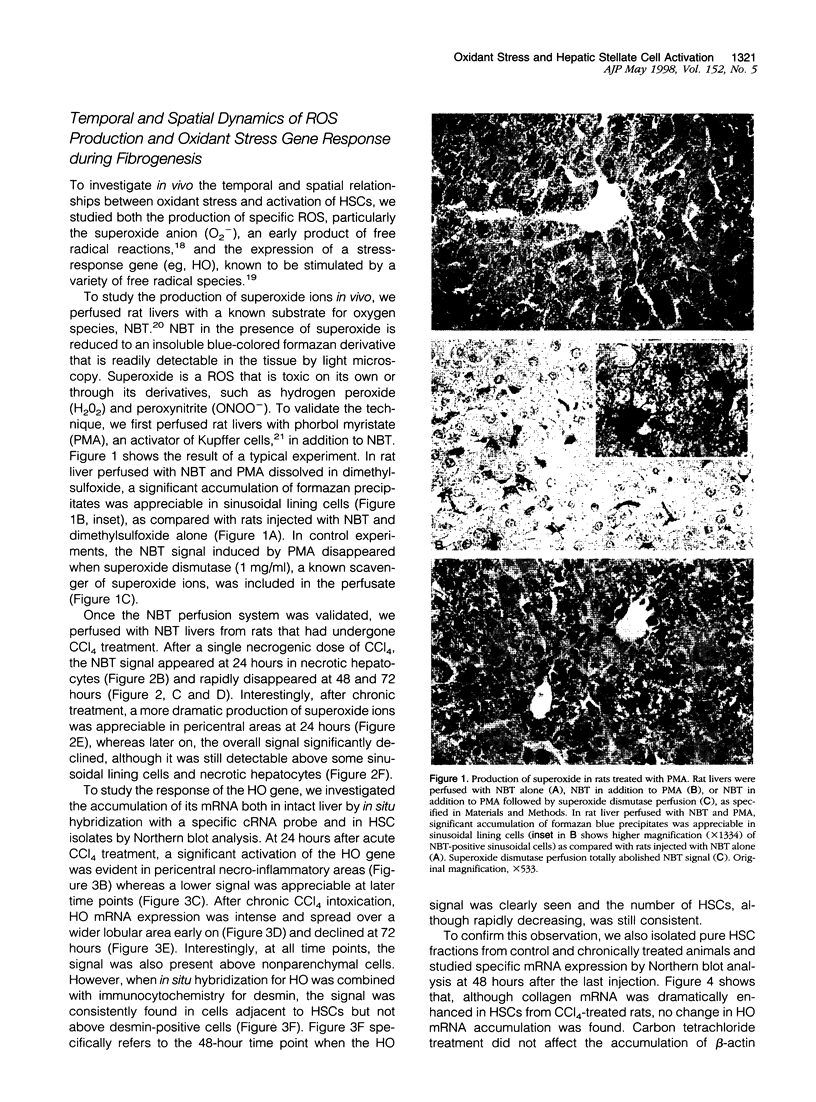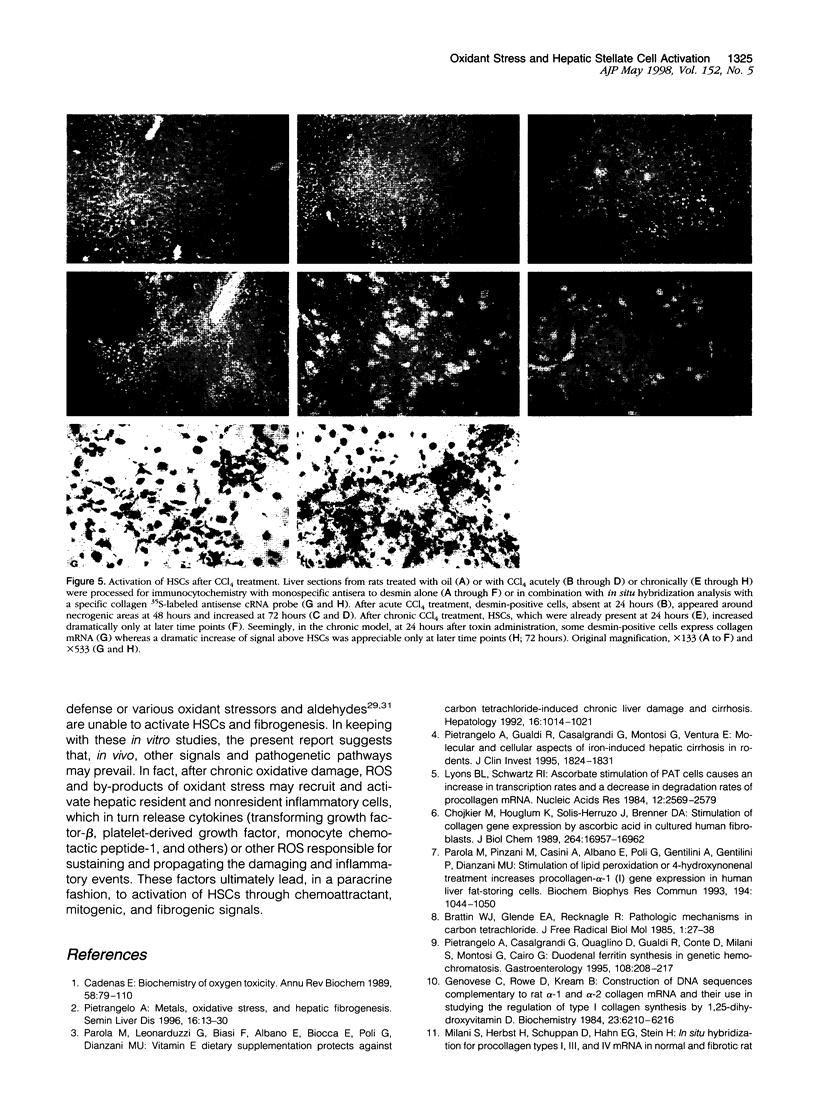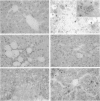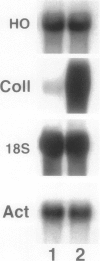Abstract
In vitro and in vivo studies indicate that oxidant stress is implicated in liver fibrogenesis. However, it is still unknown whether, in vivo, oxidant stress directly affects the hepatic cells responsible for fibrogenesis, ie, the hepatic stellate cells (HSCs). This study was aimed at answering this question by assessing the temporal and spatial relationships between oxidant stress and activation of HSCs in an in vivo model of oxidant-stress-associated fibrogenesis. To this purpose, rats were treated with carbon tetrachloride (CCl4) and livers subjected to in situ perfusion with nitroblue tetrazolium, which, in the presence of superoxide ions, is reduced to an insoluble blue-colored formazan derivative and is readily detectable in the tissue by light microscopy. Moreover, various combinations of in situ hybridization and immunocytochemical analyses were performed. An acute dose of CCl4 caused a transient production of superoxide radicals at 24 hours into pericentral necrotic areas, whereas HSC appearance and expression of collagen mRNA were detectable only at 48 and 72 hours. After chronic CCl4 intoxication, higher levels of oxygen radical production in necrotic areas were detectable along with dramatic and sustained activation of HSCs. However, maximal HSC activation was still delayed as compared with superoxide production. Expression of heme oxygenase, a gene responsive to a variety of oxidant stress mediators, was strongly enhanced by chronic CCl4 administration but remained unchanged in HSCs, both in situ and after isolation of pure HSC fractions from control and CCl4-treated animals. In conclusion, during postnecrotic fibrogenesis, oxidant stress anticipates HSC activation. HSCs do not directly face an oxidant stress while engaged in active fibrogenesis.
Full text
PDF







Images in this article
Selected References
These references are in PubMed. This may not be the complete list of references from this article.
- Arnheim N., Treco D., Taylor B., Eicher E. M. Distribution of ribosomal gene length variants among mouse chromosomes. Proc Natl Acad Sci U S A. 1982 Aug;79(15):4677–4680. doi: 10.1073/pnas.79.15.4677. [DOI] [PMC free article] [PubMed] [Google Scholar]
- Brattin W. J., Glende E. A., Jr, Recknagel R. O. Pathological mechanisms in carbon tetrachloride hepatotoxicity. J Free Radic Biol Med. 1985;1(1):27–38. doi: 10.1016/0748-5514(85)90026-1. [DOI] [PubMed] [Google Scholar]
- Cadenas E. Biochemistry of oxygen toxicity. Annu Rev Biochem. 1989;58:79–110. doi: 10.1146/annurev.bi.58.070189.000455. [DOI] [PubMed] [Google Scholar]
- Chojkier M., Houglum K., Solis-Herruzo J., Brenner D. A. Stimulation of collagen gene expression by ascorbic acid in cultured human fibroblasts. A role for lipid peroxidation? J Biol Chem. 1989 Oct 5;264(28):16957–16962. [PubMed] [Google Scholar]
- Cleveland D. W., Lopata M. A., MacDonald R. J., Cowan N. J., Rutter W. J., Kirschner M. W. Number and evolutionary conservation of alpha- and beta-tubulin and cytoplasmic beta- and gamma-actin genes using specific cloned cDNA probes. Cell. 1980 May;20(1):95–105. doi: 10.1016/0092-8674(80)90238-x. [DOI] [PubMed] [Google Scholar]
- Friedman S. L. Seminars in medicine of the Beth Israel Hospital, Boston. The cellular basis of hepatic fibrosis. Mechanisms and treatment strategies. N Engl J Med. 1993 Jun 24;328(25):1828–1835. doi: 10.1056/NEJM199306243282508. [DOI] [PubMed] [Google Scholar]
- Genovese C., Rowe D., Kream B. Construction of DNA sequences complementary to rat alpha 1 and alpha 2 collagen mRNA and their use in studying the regulation of type I collagen synthesis by 1,25-dihydroxyvitamin D. Biochemistry. 1984 Dec 4;23(25):6210–6216. doi: 10.1021/bi00320a049. [DOI] [PubMed] [Google Scholar]
- Halliwell B. Antioxidants in human health and disease. Annu Rev Nutr. 1996;16:33–50. doi: 10.1146/annurev.nu.16.070196.000341. [DOI] [PubMed] [Google Scholar]
- Halliwell B., Gutteridge J. M. Role of free radicals and catalytic metal ions in human disease: an overview. Methods Enzymol. 1990;186:1–85. doi: 10.1016/0076-6879(90)86093-b. [DOI] [PubMed] [Google Scholar]
- Hultcrantz R., Bissell D. M., Roll F. J. Iron mediates production of a neutrophil chemoattractant by rat hepatocytes metabolizing ethanol. J Clin Invest. 1991 Jan;87(1):45–49. doi: 10.1172/JCI114999. [DOI] [PMC free article] [PubMed] [Google Scholar]
- Lee K. S., Buck M., Houglum K., Chojkier M. Activation of hepatic stellate cells by TGF alpha and collagen type I is mediated by oxidative stress through c-myb expression. J Clin Invest. 1995 Nov;96(5):2461–2468. doi: 10.1172/JCI118304. [DOI] [PMC free article] [PubMed] [Google Scholar]
- Lyons B. L., Schwarz R. I. Ascorbate stimulation of PAT cells causes an increase in transcription rates and a decrease in degradation rates of procollagen mRNA. Nucleic Acids Res. 1984 Mar 12;12(5):2569–2579. doi: 10.1093/nar/12.5.2569. [DOI] [PMC free article] [PubMed] [Google Scholar]
- Maher J. J., Neuschwander-Tetri B. A. Manipulation of glutathione stores in rat hepatic stellate cells does not alter collagen synthesis. Hepatology. 1997 Sep;26(3):618–623. doi: 10.1002/hep.510260313. [DOI] [PubMed] [Google Scholar]
- Parola M., Leonarduzzi G., Biasi F., Albano E., Biocca M. E., Poli G., Dianzani M. U. Vitamin E dietary supplementation protects against carbon tetrachloride-induced chronic liver damage and cirrhosis. Hepatology. 1992 Oct;16(4):1014–1021. doi: 10.1002/hep.1840160426. [DOI] [PubMed] [Google Scholar]
- Parola M., Pinzani M., Casini A., Albano E., Poli G., Gentilini A., Gentilini P., Dianzani M. U. Stimulation of lipid peroxidation or 4-hydroxynonenal treatment increases procollagen alpha 1 (I) gene expression in human liver fat-storing cells. Biochem Biophys Res Commun. 1993 Aug 16;194(3):1044–1050. doi: 10.1006/bbrc.1993.1927. [DOI] [PubMed] [Google Scholar]
- Perez H. D., Weksler B. B., Goldstein I. M. Generation of a chemotactic lipid from a arachidonic acid by exposure to a superoxide-generating system. Inflammation. 1980 Sep;4(3):313–328. doi: 10.1007/BF00915032. [DOI] [PubMed] [Google Scholar]
- Pietrangelo A., Casalgrandi G., Quaglino D., Gualdi R., Conte D., Milani S., Montosi G., Cesarini L., Ventura E., Cairo G. Duodenal ferritin synthesis in genetic hemochromatosis. Gastroenterology. 1995 Jan;108(1):208–217. doi: 10.1016/0016-5085(95)90026-8. [DOI] [PubMed] [Google Scholar]
- Pietrangelo A., Gualdi R., Casalgrandi G., Geerts A., De Bleser P., Montosi G., Ventura E. Enhanced hepatic collagen type I mRNA expression into fat-storing cells in a rodent model of hemochromatosis. Hepatology. 1994 Mar;19(3):714–721. doi: 10.1002/hep.1840190325. [DOI] [PubMed] [Google Scholar]
- Pietrangelo A., Gualdi R., Casalgrandi G., Montosi G., Ventura E. Molecular and cellular aspects of iron-induced hepatic cirrhosis in rodents. J Clin Invest. 1995 Apr;95(4):1824–1831. doi: 10.1172/JCI117861. [DOI] [PMC free article] [PubMed] [Google Scholar]
- Pietrangelo A. Metals, oxidative stress, and hepatic fibrogenesis. Semin Liver Dis. 1996 Feb;16(1):13–30. doi: 10.1055/s-2007-1007215. [DOI] [PubMed] [Google Scholar]
- Shibahara S., Müller R., Taguchi H., Yoshida T. Cloning and expression of cDNA for rat heme oxygenase. Proc Natl Acad Sci U S A. 1985 Dec;82(23):7865–7869. doi: 10.1073/pnas.82.23.7865. [DOI] [PMC free article] [PubMed] [Google Scholar]
- Stoyanovsky D. A., Cederbaum A. I. Thiol oxidation and cytochrome P450-dependent metabolism of CCl4 triggers Ca2+ release from liver microsomes. Biochemistry. 1996 Dec 10;35(49):15839–15845. doi: 10.1021/bi961295p. [DOI] [PubMed] [Google Scholar]
- Takahashi T., Sugimoto N., Takahata K., Okamoto T., Kishi T. Cellular antioxidant defense by a ubiquinol-regenerating system coupled with cytosolic NADPH-dependent ubiquinone reductase: protective effect against carbon tetrachloride-induced hepatotoxicity in the rat. Biol Pharm Bull. 1996 Aug;19(8):1005–1012. doi: 10.1248/bpb.19.1005. [DOI] [PubMed] [Google Scholar]
- Uehara K., Maruyama N., Huang C. K., Nakano M. The first application of a chemiluminescence probe, 2-methyl-6-[p-methoxyphenyl]-3,7-dihydroimidazo[1,2-a]pyrazin-3-one (MCLA), for detecting O2- production, in vitro, from Kupffer cells stimulated by phorbol myristate acetate. FEBS Lett. 1993 Dec 6;335(2):167–170. doi: 10.1016/0014-5793(93)80722-7. [DOI] [PubMed] [Google Scholar]
- Willis D., Moore A. R., Frederick R., Willoughby D. A. Heme oxygenase: a novel target for the modulation of the inflammatory response. Nat Med. 1996 Jan;2(1):87–90. doi: 10.1038/nm0196-87. [DOI] [PubMed] [Google Scholar]







